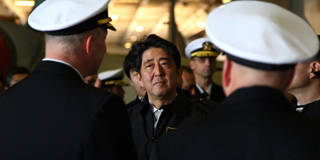The signing of the Trans-Pacific Partnership is perhaps the boldest step that Prime Minister Shinzo Abe has taken in his efforts to revitalize Japan, because it will force long-cossetted industries and the agricultural sector to innovate and compete in new ways. Nothing less will enable Japan's economy to regain its vigor.
TOKYO – On October 5, after years of exhausting – and exhaustive – haggling, a dozen Pacific Rim countries finally signed up to the Trans-Pacific Partnership (TPP), an agreement that promises everything from more trade to a cleaner environment. The negotiations were such that the hair of Akira Amari, Japan’s economic and fiscal policy minister, turned completely grey. His solace, however, is that the TPP will prove to be a key foundation stone of the “Asian Century.”
The TPP’s origins, pre-dating Amari’s involvement, go back to a 2006 trade agreement among only Singapore, New Zealand, Chile, and Brunei – the so-called “Pacific 4.” The United States, Australia, Peru, and Vietnam, seeing the prospect of a rules-based international order in Asia, joined the talks in March 2010, and in an instant the P-4’s small boat became a great ocean liner.
And then it became a convoy, as Malaysia, Mexico, Canada, and finally – in 2013 – Japan joined the negotiations. Combined, the TPP economies account for some 40% of world GDP, outstripping the largest existing free-trade area, the European Union. Once the TPP enters into effect, its impact on the global economy will undoubtedly be monumental – even without the participation of China, which on a purchasing-power-parity basis is now the world’s biggest economy.

TOKYO – On October 5, after years of exhausting – and exhaustive – haggling, a dozen Pacific Rim countries finally signed up to the Trans-Pacific Partnership (TPP), an agreement that promises everything from more trade to a cleaner environment. The negotiations were such that the hair of Akira Amari, Japan’s economic and fiscal policy minister, turned completely grey. His solace, however, is that the TPP will prove to be a key foundation stone of the “Asian Century.”
The TPP’s origins, pre-dating Amari’s involvement, go back to a 2006 trade agreement among only Singapore, New Zealand, Chile, and Brunei – the so-called “Pacific 4.” The United States, Australia, Peru, and Vietnam, seeing the prospect of a rules-based international order in Asia, joined the talks in March 2010, and in an instant the P-4’s small boat became a great ocean liner.
And then it became a convoy, as Malaysia, Mexico, Canada, and finally – in 2013 – Japan joined the negotiations. Combined, the TPP economies account for some 40% of world GDP, outstripping the largest existing free-trade area, the European Union. Once the TPP enters into effect, its impact on the global economy will undoubtedly be monumental – even without the participation of China, which on a purchasing-power-parity basis is now the world’s biggest economy.